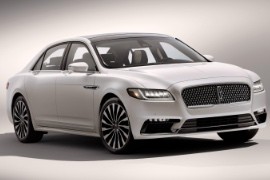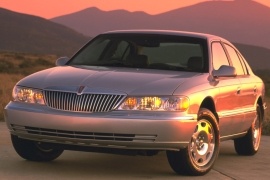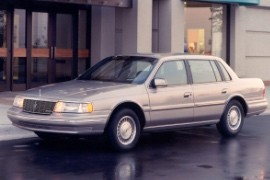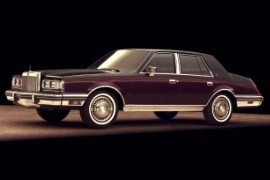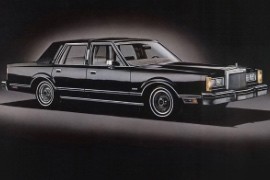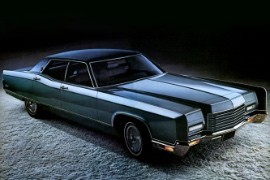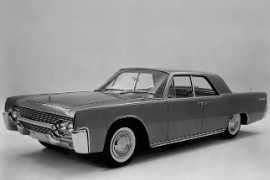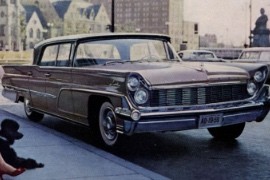LINCOLN Continental Models/Series Timeline, Specifications & Photos
First production year: 1958
Engines: Gasoline
Ford's luxury brand Lincoln returned on the market with the Continental name, after dropping the three-letter style that was adopted for several years and, in 2016, it introduced its new flagship.
The Continental name was out of the market for 14 years, but the market didn't forget it. It was the tenth generation and it offered more than any Lincoln before in terms of technology. It didn't feature the biggest engine, but it was the most powerful up to 2016.
One major component of the car was the stance. The tenth generation of the Continental featured a big chromed grille and LED headlights in the front. It didn't have an aggressive styling, but a dominant stance on the road. The three box-sedan was designed with curved and ample lines. The door handles were on a chromed line along with the bodywork and they featured a switch to open the door.
Inside, the luxury interior was designed to match the European competition. The front seats had up to 30 power adjustable ways, including the sides, the hips, the headrest, the upper side, and so on. The infotainment touch-screen was installed on the center stack. The center console resembled an airplane cockpit, but with fewer buttons on it. The instrument cluster was completely digital, with a TFT screen.
Under the hood, there was a choice of engines ranging up to 400 hp from a twin-turbo V6 unit. The all-wheel-drive system was standard for the top of the range model and offered as an option for the less-powered versions.
The ninth generation of the Continental appeared on the market just in time for the 1994 Christmas and continued the transverse-mounted V-8 engine saga into the American luxury brand.
Lincoln made a new generation for its mid-size sedan luxury vehicle to compete for the top position in the segment. While it wasn't a revolutionary car for the brand, it managed to surprise many buyers with its air-springs in all corners and three settings for its drivetrain (comfort, normal, and sport). It had all the bells and whistles for its class, but it couldn't dominate it.
Fritz Mayhew designed the car influenced by the bio-design theme. He made the car with round shapes all over the body and imagined slim headlights with corner-mounted turn signals. The raked, chromed grille featured vertical slats and contributed to the car's aerodynamic drag coefficient of just 0.32. At the back, the carmaker made the C-pillar slightly raked-forward, with a large and curved rear window. Its taillights showed a rounded outer edge and a crisp, narrow-angle on the lower inner side, towards the trunk's lid.
Inside, Lincoln managed to keep a comfortable, vast interior. The carmaker built the Continental with two interior layouts available: a five-passenger one with two bucket seats and a center console with a floor gear-selector, and a six-passenger version with a column-mounted shifter. At the back, the bench offered room enough for three occupants, but Lincoln profiled it for two.
Under the hood, the ninth Continental featured a 4.6-liter V-8 with four valves per cylinder. It provided 62 percent more power than the V-6 in the previous model while keeping almost the same figures for fuel efficiency.
Lincoln introduced the eighth generation of the Continental in 1987 for the 1988 model-year, which was more than its customers expected from this land yacht.
The Continental was already a well-known luxury vehicle on the American market. After all, the first generation was launched in 1940. But while some of its famous predecessors had to compete only against Cadillacs or Chryslers, the eighth iteration of this nameplate had to stand against European brands such as BMW and Mercedes-Benz. But Ford's luxury brand had a few aces up its sleeves.
Unlike the seventh generation, which sported wedged shapes and four squared headlights, the eighth generation of the Continental came with shaved edges and wide headlights. On the front fascia, the waterfall grille was narrower than before, and the lower bumper was rounded and made from plastic. From its profile, the elegant limo-style sedan boasted body-colored trims and a third window behind the rear doors, integrated into the C-pillars. At the back, the flat deck with sloped sides lost the bump for the spare wheel as on previous Continental generations.
Inside, the luxurious vehicle offered room for four with comfortable seats. One of its most intriguing options was the LED instrument panel, which looked futuristic for those years. At the front, Lincoln offered a wide benchseat to fit three adults or two individual seats. There was mostly room for two adults at the back due to the tall center transmission tunnel.
The Continental was available with a pneumatic, self-leveling suspension that greatly improved comfort. Moreover, a sport setting allowed the massive land yacht to perform better and become more of a driver-oriented vehicle than any another exec-limo from Lincoln's lineup.
When Ford introduced the seventh generation of the Continental in 1982, it said that it would be the best handling Lincoln to that date.
Luxury cars were not about handling or quarter-mile time, but neither in a zero to sixty 'till tomorrow category. They had to offer a good balance between performance and comfort, with more accent on the latter. That's what the Ford Fox platform promised to be for the Continental MkVII.
The design was classic for this seventh Continental generation, with a flat front area and vertical radiator flanked by four squared headlights. On the sides, there were more chromed details around the wheel arches and on the side panels. In the back, the mid-size sedan featured a spare-wheel bump on the trunk's lid, even though the tire was mounted on the left. That sloped-down rear end made the cab-rearward design looked more dynamic in a way a luxury car could be.
Inside, Lincoln lived up to its name and prepared a cabin for four with high-quality velour on the seats. The dashboard was nothing more than a wide black panel stretched between the A-pillars, at the bottom of the windshield, when the ignition was off. As soon as the key was turned in, the black panel revealed the LED displays in front of the driver and above the center stack. Everything was digital, including the speedometer, the fuel level, and the coolant temperature. A dozen buttons placed on top of the center stack showed the information for the trip computer.
Under the hood, Ford installed a standard V-6 engine which was good to crawl into city traffic. The other choice was a 5.0-liter V-8 offered in three power outputs that could provide more excitement, but not too much. The carmaker installed disc brakes in all corners to ensure a higher level of safety.
The sixth generation of the Lincoln Continental was a big leap in Ford's lineup and it was the bridge between the large Continentals and the mid-size sedan that followed.
After the Corporate Average Fuel Efficiency (CAFE for short) law imposed in 1975 after the first oil crisis, Ford worked hard to offer cars with a lower fuel consumption but that can still provide the desired comfort and luxury desired. The 1980 Lincoln Continental was the bridge between the large sedan and the mid-size sedan that followed. And it was one of the cars that helped Ford to become one of the best fuel-efficient corporate brands in the U.S.
The 1980 Continental showed the same grille with vertical slats. The four square headlights were part of an already established image of the brand. From the side, the boxy look of the car was considered imposing for the luxury American brand. A vinyl roof cover was offered as an option to mimic a four-door cabriolet.
Inside, the Continental was a big evolution, with an LED display instead of analog dials. It was a big revolution for the brand. It even featured an on-board computer that showed the average fuel consumption and range. The five seats offered were comfortable and with plenty of room for the rear passengers.
Under the hood, there was a newly developed 5.0-liter V8 engine with fuel injection, which was designed for better fuel-efficiency. The 4-speed automatic gearbox was a standard fit.
Ford introduced the luxurious Continental as a competitor for Cadillac and performed even better than some would expect.
The fifth generation of the Continental was introduced in 1970 and was based on the same platform as the Mark III generation, which was also featured under the fourth generation of the vehicle. It was, at that time, one of the most luxurious vehicles on the planet and also among the longest. In addition, it was packed with strange technological improvements, such as the auto-dimming headlights system, which was something that many other vehicles didn't have until the late 2000s.
From the outside, the squared-looking bodywork was a departure from the coke-bottle design of the rear quarter fenders featured on the fourth generation of the Continental. But the front of the car still featured the hidden headlights feature with lids that were vacuum activated from the driver's seat. From its profile, the long vehicle received a new, longer wheelbase than its predecessor, gaining about 3 inches (8 cm). At the back, there was no spare-wheel cover design anymore, leaving the trunk lid just flat.
Inside, the luxurious vehicle was fitted with a bench seat at the front and a bench in the back. Fronting the driver, there were five dials on the dashboard, from the left edge to the top of the center stack. The dashboard was completely different than on the previous Continental. It featured a scale-like speedometer, and several other gauges mounted to the left and the right of the steering wheel. Finally, the radio buttons were placed in the middle of the dash so the side passenger could access them.
Under the hood, the Continental was fitted with a 400 engine for California and a 460 for the rest of the 49 states. The only available transmission was a three-speed automatic.
The fourth generation for the Lincoln Continental appeared in 1961 and has a bad name because it was the convertible in which JFK was assassinated in 1963. But the car had other qualities for which it was very appreciated at the time. It was based on a Ford Thunderbird with an extended wheelbase and had four doors installed. The rear doors were rear-hinged (suicide doors) for easier loading and unloading of the passengers. To prevent the accidental opening during driving, a contact and a lamp on the dashboard were installed. This is how the “door ajar” warning light appeared on vehicles.
Under the hood, Ford installed a 7.0-liter V8 (430 cu-in) engine with 325 hp. The engine was replaced in 1966 by a bigger, 7.5-liter V8. All Lincoln Continentals were equipped with a 3-speed automatic transmission, produced by Ford. The first models had the Turbo-Drive automatic and the latter, since 1966, had the C6-automatic gearbox.
Some interesting features for the Lincoln Continental were the vacuum-lockable doors, adjustable height of the steering column (not tilting) and the unibody construction for the big, over 2.6 metric tons vehicle. It was heavier than its competitors, even though it was smaller. Despite its 5.5 meters length, the rear passengers didn't have enough legroom. Only after 1964, when the wheelbase was extended to 3.2 m (126 in), the passengers from the rear bench had enough room.
In 1958 Dwight D. Eisenhower was in the office, the U.S. launched its first satellite and the Barbie doll was introduced and it was an instant hit. It wasn't the same victory for the Lincoln Continental MkIII that was launched in the same year.
It was a busy year and Lincoln tried its move into the luxury car market, dominated by the Cadillac Eldorado. It was the era with big fins and Lincoln decided to outdo the competition. And it did it in every way. The Continental MKIII was available in a specific color named Presidential Black, it was bigger, heavier, and faster than the Eldorado. Unfortunately, it also consumed more fuel than the Cadillac. On a good day, the big, 5000 lbs (2268 kg) Continental could get 9 mpg (26 l/100 km), but, since the gasoline costed only about 30 cents/gallon, that wasn't a problem.
Inside, the big Continental MKIII had ceiling-mounted air-conditioning vents and other luxurious amenities for that era. But there were a few problems. Lincoln didn't put its name on the car and tried to sell it as a Continental MKIII. It didn't even have a Lincoln badge on the car.
But the real problem was that a financial crisis struck in that year, so the car sales stalled. So, the big Continental MKIII was axed and helped Lincoln to survive. The luxury brand lost USD 1000 for each and every Continental it sold. The car was mostly hand-built.
